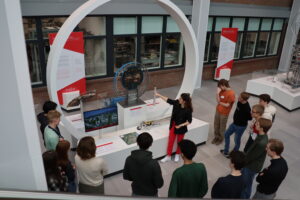A prototype of the world’s first muon accelerator will be on display at the new Nikhef Expostrip in Amsterdam starting Monday. The large copper component replaces the current cross-section from CERN of the LHC accelerator on display.
Muon colliders are circular accelerators in which electrons are not shot at each other at high energy, but muons: heavier relatives of the electron. With these, higher collision energies can be achieved and, in addition, muons lose less energy in orbit.

The new exhibition in the central Vertex hall of the newly renovated institute shows a so-called cavity of the muon collider. That’s a copper torus that uses radio waves to give a passing beam of muons more energy. The prototype was built at Fermilab in the US.
The cavity comes in the place of the cross-section of the LHC accelerator that is now central to the exhibit. “As an institute we also like to show important new ideas in our field of science”, said Martijn van Calmthout, head of communications at Nikhef.
One of the advantages of a muon collider would be that it would require a much smaller circle to achieve similar energy, and thus a much less costly tunnel. Muons, like electrons, have the advantage that they are point particles, so collisions cause fewer complications in the analyses.
“You can analyze the images from a muon collider almost by eye already, rather than with super-complicated software and lots of statistics,” says physicist Tristan Du Pree of Nikhef. He recently held a colloquium for colleagues on muon collider initiatives in the US and elsewhere.

A fundamental problem with muon colliders is that muons are unstable particles, existing for only a few microseconds after their creation and then falling apart. It is therefore complicated to use them to create intense beams suitable for serious experiments.